Conocemos esa sensación. Ese momento en el que tu sitio se cae y no tienes ni idea de por qué. Es uno de los errores más comunes de WordPress, pero también uno de los más misteriosos. No te dice lo que está mal, sólo que algo está roto.
¿La buena noticia? Casi siempre se puede solucionar. Después de haber ayudado a innumerables clientes, nos hemos enfrentado a este error con bastante frecuencia.
En esta guía, te guiaremos a través de los pasos exactos para que tu sitio vuelva a funcionar. Sólo tienes que seguir a lo largo, y usted tendrá todo funcionando de nuevo en ningún momento.
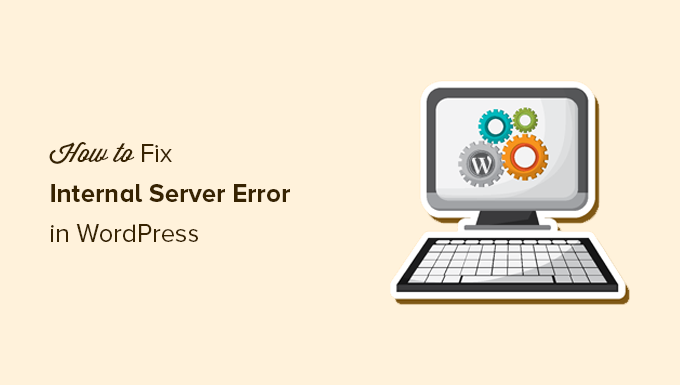
He aquí un breve resumen de los debates que abordaremos en este artículo:
- What Is the 500 Internal Server Error?
- What Causes the Internal Server Error in WordPress?
- Fixing the 500 Internal Server Error in WordPress
- Clear WordPress and Browser Cache
- Checking for Corrupt .htaccess File
- Increasing the PHP Memory Limit
- Deactivate All WordPress Plugins
- Switch to a Default WordPress Theme
- Re-Uploading Core Files
- Enable Debug Logs in WordPress
- Ask Your Hosting Provider
- Video Tutorial
¿Qué es el error 500 Internal Server Error?
El error 500 Internal Server Error es como una puerta cerrada sin llave. Sabes que algo va mal, pero no hay ninguna nota que explique qué ha pasado.
Este error no es sólo un problema de WordPress. Puede aparecer en cualquier sitio web cuando el servidor se encuentra con un problema que no sabe cómo resolver.
El “500” del mensaje es un código de estado HTTP. Si lo buscas, encontrarás una vaga definición:
“El código de respuesta 500 Internal Server Error indica que el servidor encontró una condición inesperada que le impidió cumplir con la solicitud”.
Eso no es muy útil, ¿verdad? Es la forma que tiene el servidor de decir: “Algo se ha roto, pero no estoy seguro de qué”.
El aspecto de este error depende de la configuración de su alojamiento y de su navegador. Aquí tienes un ejemplo de cómo aparece en un servidor Apache:
Si su sitio se ejecuta en Nginx, puede parecer un poco diferente. Y si Google Chrome no puede cargar una página de error adecuada, verás algo como esto:
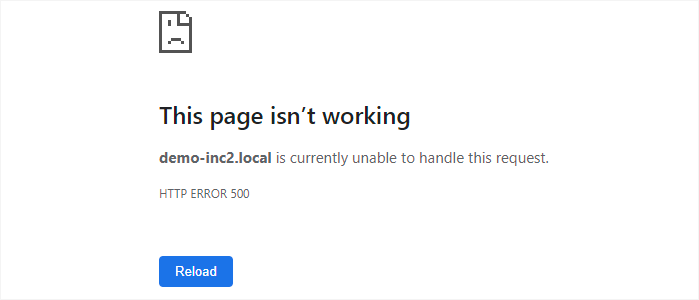
Para los principiantes, esto puede resultar abrumador. No hay ningún mensaje que explique qué ha fallado o cómo corregirlo.
Es como pedirle a un mecánico que te corrija el coche sin decirle qué se ha estropeado. Tendrán que marcar / comprobar distintas piezas hasta encontrar el problema / conflicto / incidencia.
Según nuestra experiencia, la mejor manera de corregirlo es hacerlo paso a paso. Te guiaremos a través de las causas y soluciones más comunes para que puedas hacer que tu sitio vuelva a funcionar.
Obtenga ayuda experta en cualquier momento con el soporte de WordPress bajo demanda.
Tratar con un error interno del servidor puede ser frustrante. Nuestro soporte de WordPress bajo demanda está aquí para ayudarle a corregir problemas técnicos de forma rápida y eficaz.
- Pago único para recibir soporte experto a la carta
- Plazos de entrega rápidos
- Disponible 24 horas al día, 7 días a la semana
¿Qué causa el error interno del servidor en WordPress?
El error interno del servidor en WordPress es como un puzzle al que le faltan piezas. Sabes que algo va mal, pero el mensaje de error no te dice exactamente dónde está el problema.
Según nuestra experiencia, el culpable más común es un archivo .htaccess corrupto. A veces, es un plugin o un tema que no funciona bien con tu configuración.
Otras veces, su sitio puede alcanzar el límite de memoria PHP, haciendo que WordPress se bloquee. Los archivos del núcleo corruptos también pueden desencadenar este error, dejándole bloqueado sin advertencia.
En algunos casos, el error solo aparece al intentar acceder al área de administración de WordPress, mientras que el resto del sitio funciona correctamente. Es como quedarse fuera de casa mientras los invitados pueden entrar por la puerta de atrás.
Lo que hace que este error sea complicado es que suele producirse antes de que WordPress pueda cargarse correctamente. Eso significa que el servidor no puede reunir suficientes detalles para explicar qué ha ido mal.
Si quieres saber cómo funciona WordPress entre bastidores, marca / comprueba nuestra guía sobre cómo funciona WordPress bajo el capó.
A continuación, vamos a diagnosticar los problemas para que su sitio vuelva a funcionar.
Corrección del error 500 Internal Server en WordPress
Antes de empezar a diagnosticar problemas, asegúrese de tener a mano una copia de seguridad completa de WordPress de su sitio web.
Si tiene acceso al área de administrador de WordPress, puede utilizar un plugin de copia de seguridad de WordPress para crear una copia de seguridad completa de su sitio web.
Recomendamos usar Duplicator para manejar esto. No solo te ayuda a hacer copias de seguridad rápidas de tu sitio web, sino que también puedes almacenar tus copias de seguridad en la nube y, lo que es más importante, puedes restaurar tu sitio web desde la copia de seguridad.
Por otro lado, si no tiene acceso al área de administrador de WordPress, puede crear manualmente una copia de seguridad de WordPress utilizando phpMyAdmin y un cliente FTP.
A continuación, puede seguir los siguientes pasos para diagnosticar y corregir el error interno del servidor en su sitio web.
Vaciar la caché de WordPress y del navegador
Los navegadores y sus plugins de caché de WordPress pueden a veces almacenar por error una copia en caché de una página de error.
La forma más fácil de corregirlo es vaciando primero la memoria caché del navegador.
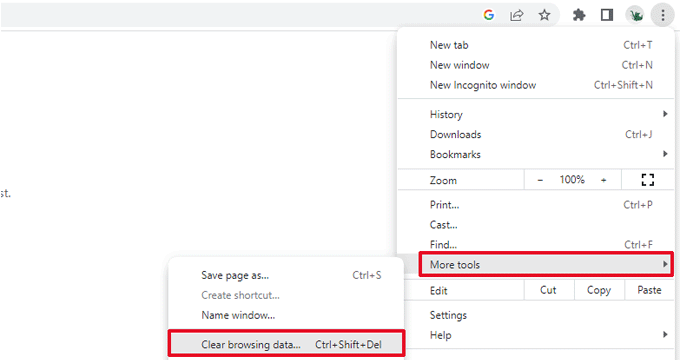
Después, si tiene acceso al área de administrador de WordPress de su sitio web, puede vaciar la caché de WordPress visitando la página de ajustes de su plugin de caché.
Para más detalles, consulte nuestro tutorial sobre cómo vaciar la caché de WordPress.
Comprobar si el archivo .htaccess está dañado
El archivo .htaccess es un archivo de configuración del servidor utilizado por WordPress para establecer las redirecciones.
Una de las causas más comunes de error interno del servidor es el archivo .htaccess corrupto.
La forma más fácil de establecer esto es simplemente visitando la página de Ajustes ” Enlaces permanentes en el área de administración de WordPress y luego haciendo clic en el botón “Guardar cambios” sin hacer ningún cambio.
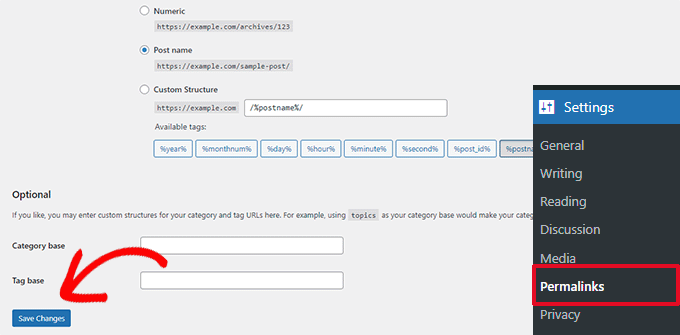
WordPress intentará actualizar su archivo .htaccess o generar uno nuevo. Ahora puede visitar su sitio web para comprobar si se ha resuelto el error interno del servidor.
Si aún puede ver el error, entonces necesita asegurarse de que WordPress pudo generar o escribir en el archivo .htaccess.
A veces, debido a los permisos de archivos y directorios, es posible que WordPress no haya podido crear o escribir en su archivo .htaccess.
Ahora puede intentar reemplazar el archivo .htaccess manualmente. En primer lugar, debe acceder a su sitio web mediante FTP o la aplicación Administrador de archivos del panel de control de su cuenta de alojamiento.
A continuación, debe renombrar suarchivo .htaccess principal a algo como .htaccess_old. Esto le permite mantener el archivo como una copia de seguridad, pero WordPress no lo reconocerá.
Para cambiar el nombre del archivo .htaccess, deberá acceder a su sitio mediante FTP o la aplicación Administrador de archivos del panel de control cPanel de su cuenta de alojamiento.
Una vez conectado, el archivo .htaccess estará ubicado en el mismo directorio donde verá carpetas como wp-content, wp-admin y wp-includes.
Simplemente haga clic con el botón derecho en el archivo .htaccess y cámbiele el nombre a .htaccess_old.
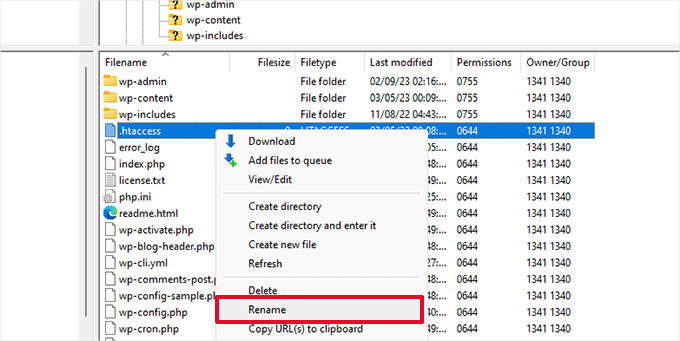
A continuación, debe crear un nuevo archivo .htaccess.
Dentro de la carpeta raíz de su sitio, haga clic con el botón derecho del ratón y seleccione la opción “Crear nuevo archivo” en su cliente FTP o aplicación de gestión de archivos.
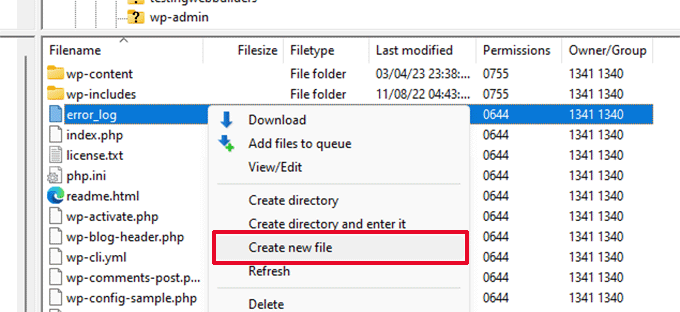
Nombre este nuevo archivo .htaccess y haga clic en “Aceptar” para guardarlo.
Ahora, este archivo .htaccess está actualmente vacío, y necesita añadirle reglas de reescritura por defecto de WordPress.
Sólo tienes que hacer clic con el botón derecho en el archivo y seleccionar “Ver/Editar” en tu cliente FTP o aplicación de gestión de archivos.
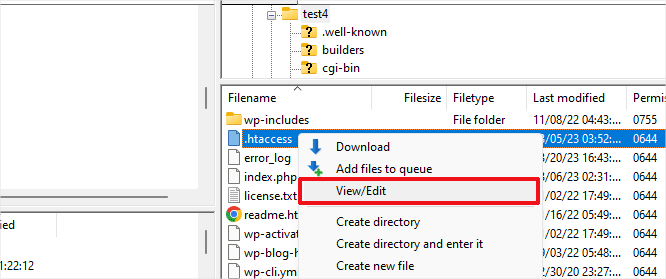
El archivo vacío se abrirá en un editor de texto plano como Notepad o TextEdit.
Ahora, tienes que copiar y pegar el siguiente código en su interior:
1 2 3 4 5 6 7 8 9 10 | # BEGIN WordPress<IfModule mod_rewrite.c>RewriteEngine OnRewriteBase /RewriteRule ^index.php$ - [L]RewriteCond %{REQUEST_FILENAME} !-fRewriteCond %{REQUEST_FILENAME} !-dRewriteRule . /index.php [L]</IfModule># END WordPress |
Este código es el conjunto de reglas por defecto utilizado por WordPress. No olvide guardar los cambios y volver a subir el archivo al servidor.
Ahora puede visitar su sitio web para comprobar si se ha resuelto el error interno del servidor.
Si es así, date una palmadita en la espalda porque has corregido el error interno del servidor.
Importante: Antes de continuar con otras cosas, asegúrese de ir a la página Ajustes ” Enlaces permanentes en el área de administrador de WordPress y haga clic en el botón Guardar sin realizar ningún cambio. Esto regenerará el archivo .htaccess con las reglas de reescritura adecuadas para garantizar que las páginas de entradas no devuelvan un error 404.
Si la solución de comprobar si el archivo .htaccess está corrupto no le ha funcionado, entonces tiene que seguir leyendo este artículo.
Aumentar el límite de memoria PHP
A veces, el error interno del servidor puede ocurrir si un script consume todo el límite de memoria PHP.
La forma más fácil de aumentar el límite de memoria PHP es editando el archivo wp-config.php. Tenga cuidado al hacer esto si usted es un principiante. Usted quiere seguir estas instrucciones cuidadosamente porque incluso pequeños errores en los archivos del núcleo de WordPress pueden romper su sitio.
Para empezar, sólo tiene que conectarse a su sitio web WordPress mediante un cliente FTP o la aplicación Administrador de archivos del panel de control de su cuenta de alojamiento.
Encontrarás el archivo wp-config.php dentro de la carpeta principal de tu sitio web. Haz clic con el botón derecho y selecciona “Descargar”. Esto te asegurará que tienes una copia de seguridad del archivo en caso de que algo vaya mal.
Cuando lo hayas guardado, puedes hacer clic con el botón derecho y seleccionar “Ver/Editar”.
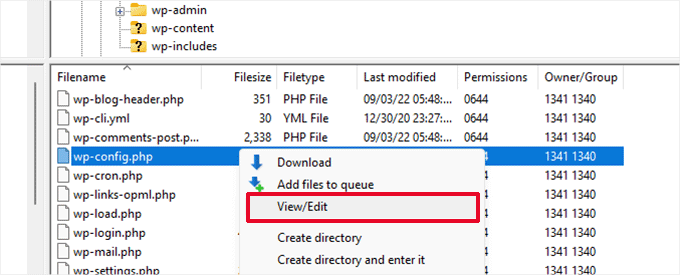
Dentro del archivo wp-config.php, debe añadir el siguiente código justo encima de la línea que dice: ‘¡Eso es todo, deje de editar! Feliz publicación’:
1 | define( 'WP_MEMORY_LIMIT', '256M' ); |
Para más detalles, consulte nuestro tutorial sobre cómo aumentar el límite de memoria PHP en WordPress.
Nota: Si 256M no resuelve el problema, intente aumentarlo a 512M.
Si ve el error interno del servidor solo cuando intenta acceder a su administrador de WordPress o subir una imagen en su wp-admin, entonces debe aumentar el límite de memoria siguiendo estos pasos:
- Crea un archivo de texto en blanco en tu ordenador y llámalo php.ini
- Pega este código: memory=256MB
- Guardar el archivo
- Súbelo a tu carpeta /wp-admin/ usando FTP
Si aumentar el límite de memoria te ha corregido el problema, entonces solo lo has hecho temporalmente. Todavía tienes que encontrar la causa que está agotando tu límite de memoria.
Podría tratarse de un plugin mal codificado o incluso de una función del tema. Le recomendamos encarecidamente que pida a su empresa de alojamiento web de WordPress que revise los registros del servidor para ayudarle a encontrar el diagnóstico exacto.
Si al aumentar el límite de memoria PHP no se ha corregido el problema, es necesario diagnosticar más problemas.
Desactivar todos los plugins de WordPress
Si ninguna de las soluciones anteriores le ha funcionado, lo más probable es que este error esté causado por un plugin específico instalado en su sitio web.
También es posible que se trate de una combinación de plugins que no funcionan bien entre sí.
Si puede acceder al área de administrador de WordPress de su sitio web, sólo tiene que ir a la página de plugins y desactivar todos los plugins de WordPress.
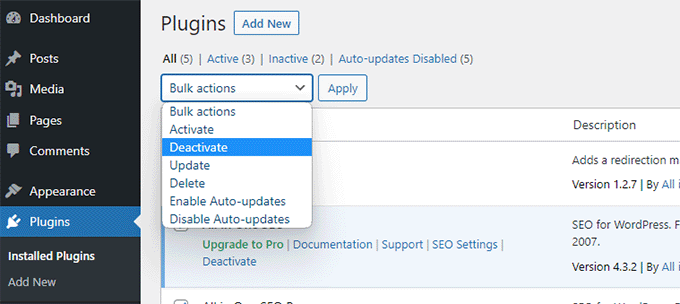
Sin embargo, si no se ha podido acceder al área de administrador de WordPress, se pueden desactivar todos los plugins de WordPress mediante FTP.
Sólo tienes que conectarte a tu sitio web WordPress mediante un cliente FTP o la aplicación de gestión de archivos del panel de control de tu cuenta de alojamiento.
Una vez conectado, vaya a la carpeta /wp-content/ y cambie el nombre de la carpeta plugins a plugins.deactivated.
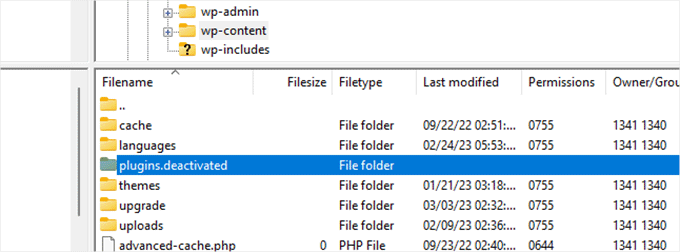
WordPress busca los plugins en la carpeta plugins. Si no encuentra la carpeta de plugins, desactivará automáticamente todos los plugins.
Ahora puede intentar visitar su sitio web para ver si esto ha resuelto el error interno del servidor en su sitio web.
Para restaurar todos tus plugins, puedes simplemente renombrar la carpeta ‘plugins.deactivated’ de nuevo a plugins.
Tus plugins se restaurarán, pero seguirán desactivados.
Ahora puede activar plugins individualmente y visitar su sitio web para averiguar qué plugin está causando el error interno del servidor.
Para más detalles, consulte nuestra guía sobre cómo desactivar todos los plugins de WordPress sin wp-admin.
Si la desactivación de todos los plugins no ha corregido el error interno del servidor en su sitio web, siga leyendo.
Cambiar a un tema predeterminado de WordPress
Una posible causa del error interno del servidor podría ser algún código de su tema de WordPress.
Para determinar si este es el caso, necesita cambiar su tema a un tema por defecto de WordPress.
Si tiene acceso al área de administrador de WordPress, vaya a la página Apariencia ” Temas. Si tienes un tema por defecto ya instalado, entonces puedes simplemente hacer clic en el botón Activar para cambiar el tema.
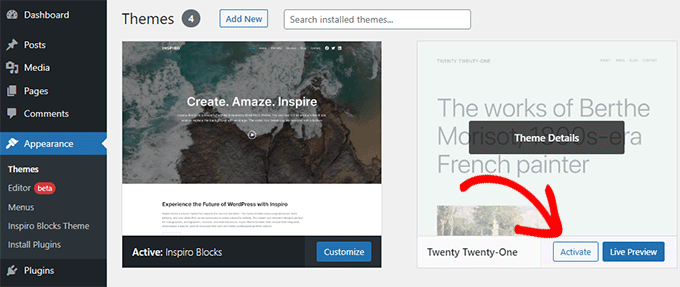
Si no tiene instalado un tema por defecto, puede hacer clic en el botón “Añadir nuevo” de la parte superior e instalar un tema por defecto (Twenty Twenty-Three, Twenty Twenty-Two, etc.).
Si no tienes acceso al área de administrador de WordPress, puedes cambiar a un tema por defecto.
Simplemente conéctese a su sitio web WordPress utilizando un cliente FTP y navegue hasta la carpeta /wp-content/.
Haz clic con el botón derecho para seleccionar la carpeta de temas y descárgala en tu ordenador como copia de seguridad.
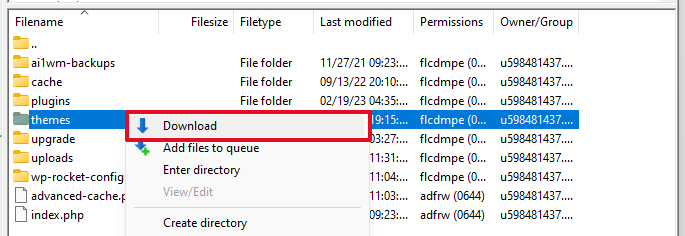
Lo siguiente que tienes que hacer es borrar la carpeta de temas de tu sitio web. Una vez que se borra, seguir adelante y crear una nueva carpeta de temas.
Su nueva carpeta de temas estará completamente vacía, lo que significa que no tiene ningún tema de WordPress instalado en este momento.
A continuación, debe visitar el directorio de temas de WordPress y descargar un tema de WordPress por defecto en su ordenador.
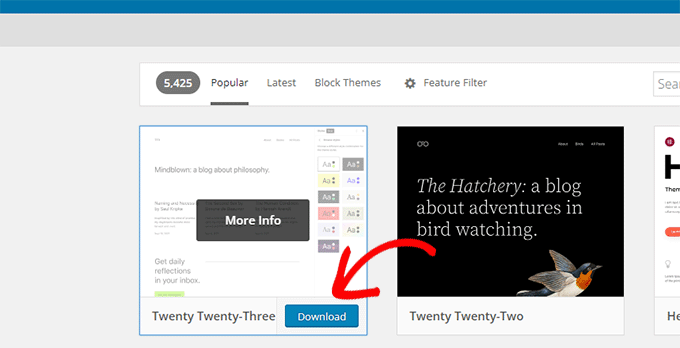
A continuación, su navegador descargará el tema como archivo zip en su ordenador.
Localice el archivo en su ordenador y descomprímalo. Los usuarios de Windows pueden descomprimir el archivo haciendo clic con el botón derecho y seleccionando “Extraer todo”. Los usuarios de Mac pueden hacer doble clic en el archivo zip para extraerlo.
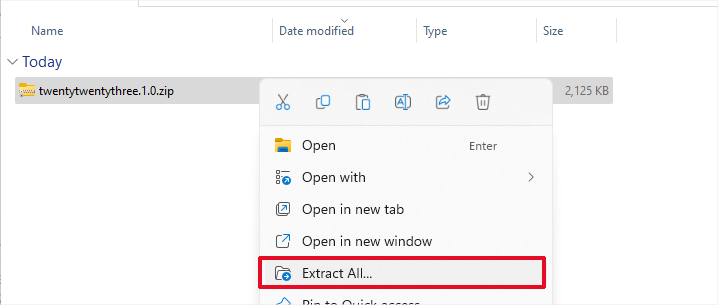
Ahora verá una carpeta que contiene su tema de WordPress.
Vuelva a su cliente FTP o al gestor de archivos y suba esta carpeta a la carpeta de temas vacía.
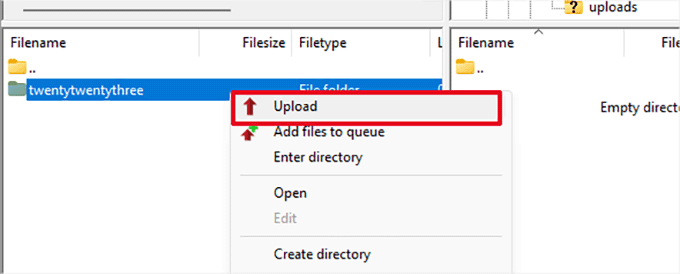
Una vez subido, WordPress empezará a utilizar automáticamente el tema por defecto.
Ahora puede visitar su sitio web para comprobar si se ha resuelto el error interno del servidor.
Si esto no funciona, puede volver a cargar sus temas de WordPress desde la copia de seguridad o volver al tema que estaba utilizando.
No se preocupe. Todavía hay algunas cosas más que puede hacer para corregir el error.
Volver a subir archivos del núcleo
Si las opciones del plugin y del tema no han corregido el error interno del servidor, vale la pena volver a cargar las carpetas /wp-admin/ y /wp-includes/ desde una nueva instalación de WordPress.
Esto NO eliminará ninguno de sus datos, pero puede solucionar el problema en caso de que algún archivo esté dañado.
En primer lugar, tendrás que visitar el sitio web WordPress.org y hacer clic en el botón “Descargar”.
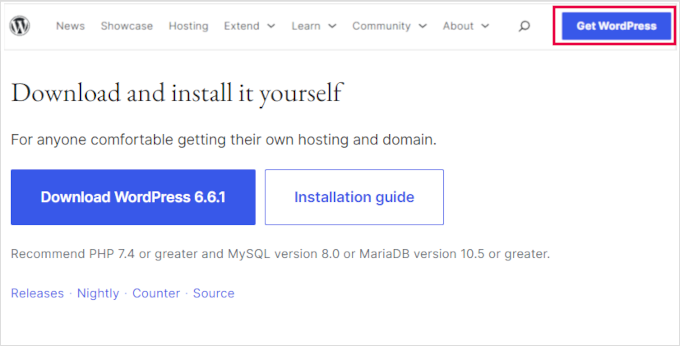
Esto descargará el archivo zip de WordPress en su ordenador.
Extraiga el archivo zip. Dentro de él, encontrará una carpeta wordpress.

A continuación, debe conectarse a su sitio web WordPress mediante un cliente FTP.
Una vez conectado, vaya a la carpeta raíz de su sitio web. Es la carpeta que contiene las carpetas wp-admin, wp-includes y wp-content.
En la columna de la izquierda, abra la carpeta WordPress de su ordenador.
Ahora tienes que seleccionar todos los archivos dentro de la carpeta de wordpress y subirlos a tu sitio web.
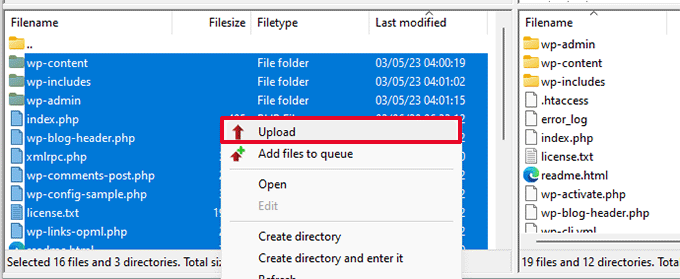
Tu cliente FTP transferirá ahora esas carpetas a tu servidor.
Le preguntará si desea sobrescribir los archivos. Seleccione “Sobrescribir”, luego seleccione “Utilizar siempre esta acción” y marque la casilla de verificación “Aplicar solo a la cola actual”.
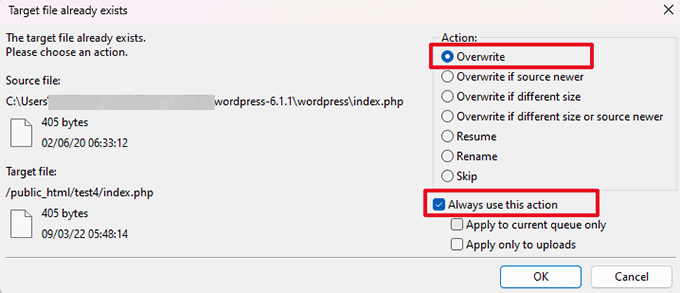
Su cliente FTP sustituirá sus archivos antiguos de WordPress por copias nuevas y actualizadas.
Si sus archivos de WordPress se corrompieron, este paso corregirá el error interno del servidor.
Activar los registros de depuración en WordPress
WordPress viene con un sistema incorporado para mantener los registros para depurar.
Puedes activarlo usando el plugin WP Debugging. Para más detalles, consulta nuestra guía sobre cómo instalar un plugin de WordPress.
Una vez activado, el plugin activará los registros de depuración en su sitio web WordPress.
Si no tiene acceso al área de administrador de su sitio web WordPress, puede activar la depuración añadiendo el siguiente código a su archivo wp-config.php:
1 2 | define( 'WP_DEBUG', true);define( 'WP_DEBUG_LOG', true); |
Una vez que haya activado los registros de depuración, puede verlos utilizando un cliente FTP y navegando hasta la carpeta /wp-content/.
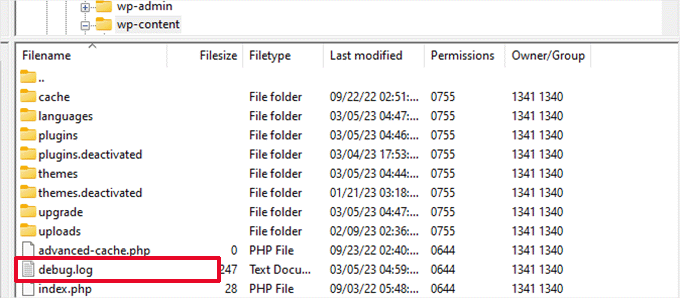
Puede abrir el archivo de registro de depuración en un editor de texto, y se le mostrará una lista de los errores y advertencias que se producen en su sitio web.
Algunos errores y advertencias pueden ser incidentes inofensivos que no necesitan corrección. Sin embargo, si ves un error interno del servidor en tu sitio web, entonces estos pueden indicarte la dirección correcta.
Pregunte a su proveedor de alojamiento
Si todos los métodos fallan a la hora de corregir el error interno del servidor en su sitio web, entonces es el momento de obtener algo más de ayuda.
Póngase en contacto con el equipo de soporte de su alojamiento web, y ellos podrán marcar / comprobar los registros del servidor y localizar la causa del error.
Si quieres seguir diagnosticando por tu cuenta, consulta nuestra guía definitiva para diagnosticar problemas en WordPress para principiantes.
Tutorial en vídeo
If you liked this article, then please subscribe to our YouTube Channel for WordPress video tutorials. You can also find us on Twitter and Facebook.





Ryan
I get the same Internal Server Error happening every couple of weeks now.
Each time it’s an issue with the .htaccess file, it’s an easy fix to get the site up and running thanks to the info you provided above but is there anything I can do that will prevent the error re-occurring?
Thanks.
carl
Thanks dude, you saved my beans and saved me from some real hassle. Super Kudos
Anil
Any advice for intermittent 500 errors?
WHITEFEATHER HUNTER
I tried renaming the htaccess file to htaccess_old like you said, and it disappeared! Now I get 404 errors every time I try to load the website’s various pages.
My original problem was indeed the plugins – deactivating them brought my website back online. However, NOW I have this 404 problem.
Also, I cannot find a Settings option in FileZilla – can you please help?
Thanks!
Chad Warren
The reason you are receiving 404 errors is because you have renamed your .htaccess file The .htaccess file contains the rewrite code to make your links pretty. ie: http://www.example.com/about instead of http://www.example.com/?p=259
The simplest way to correct this is to log into the WP admin and go to Settings >> Permalinks Make sure you have the proper permalink option selected and then Save. This will recreate the the proper rewrite peramaters within .htaccess
Previsha
Thank you so much, Changing the .htaccess file worked.
Norman Fellows
Hi Editorial Staff!
Checking for the corrupt .htaccess file solution worked for me. Thank you.
I had been doing a lot of work on the site including updating Jetpack. Not sure what the culprit was but I was completely locked out…
Matthew
Pretty useful! Good job Syed.
aiyeboy
thanks but whenever i rename the htaccess the site comes up and goes down after 1 minute again and this as been keeping my website offline for days now….helpppp
WPBeginner Support
Why would you rename htaccess file? Delete any .htaccess file you have renamed including the original .htaccess file.
Admin
aiyeboy
you mean i should delete my htaccess file , but it automatically comes back.
WPBeginner Support
Yes it does, if your .htaccess file had some problem then deleting it should have solved it.
Owolabi
You Guys are great ! I always find solution to my problems here. once again tank you and keep the good work up.
Cheers!
pushkar
Nothing of the above worked. It seems the problem was with my wordpress Theme. I changed to another theme and the website is back to normal. This link shows how to change the theme without a working admin http://wordpress.shadowlantern.com/change-wordpress-theme-in-phpmyadmin/
WPBeginner Support
You can also change your theme by deleting all themes and only leaving the theme that you want to use in /wp-content/themes directory.
Admin
viksit singh
Really work’s thanks dude
It’s good Nice post Having a great knowledge about that…
Please Help i want a hosting service which is cheep giv me domain and Support
Thanks
Jayson T Cote
I wanted to add another situation that may cause Internal Server errors and can be easily remedied.
Check your php.ini file usually located in your root directory on your web hosting server.
I recently updated our server from PHP version 5.3.x to 5.4.x The update changed a few PHP options which were set differently in the local php.ini file. We made the same changes to the website’s local php.ini file as we did on the server and eliminated the Internal Server error.
Take caution, you can try renaming the php.ini file (php.ini.old) and reload your website to see if it makes a difference. Looking at the servers error logs will determine the exact PHP option in question that will need to be edited in your local php.ini file.
Bill Cruz
Thank you based god! renaming my .htaccess file and forcing a new one to be created resolved my blank webpage! I reset my mySQL database password, and updated the password on the wp-config.php file, but that still didn’t fix it, but this method did. Thanks.
Mikkel Lindblom
Thank you! Allways remember to check the .htaccess file
Mert Can
Hi,
I would like to ask you, how can I edit this error file (Internal Server Error)? Because it’s showing there my e-mail address. I am using linux Debian 7.
Thanks,
Best Regards,
Vyacheslav
Thank you for such a good article. This set of fixes is really handy to keep them all at fingertips.
My problem was the .htaccess file, but not the one in the root folder. It was rather the one in my /wp-admin folder. It came about that I protected /wp-admin folder with a password by means of host provider panel. It created the .htaccess file inside my /wp-admin folder. I also added some code into the file too.
Later I turned such a password protection of the folder off, so the code added by host provider panel itself was taken from the .htaccess file automatically. Meanwhile the code added by me still remained in the file. This piece of code caused the problem leading to Internal Server Error 500.
I just removed the .htaccess file due to its lack of necessity and it did the trick.
Vijay Sharma
Yes, it works for me to get the idea,
Solutions process I did
1. Define Php memory limit in “wp-config.php”
2. Deactivate all plugins
3. Update permalinks structure
4. Activate plugin one by one
NatalieDawn
Hey,
I have loads of problems with 503 error. My host told me it’s a problem with index.php file. Don’t know, how to solve it, HELP PLEASE! (I’m really desperate now ).
).
Asha Singh
Can i fix by uploading manual file or need to change any hosting file of ny site . because it has same issue several times at my end.
Thanks for info.
WPBeginner Support
Yes you can try uploading fresh copies of files to your server overwriting any existing files you might have. Please backup first.
Admin
Paul
yes I went through all the steps and as always my luck get the hardest, reinstalled via ftp job done!
Piers
Hooray, the .htaccess thing did the trick. Thanks so much for the valuable tips.
Yogesh
goooooooooooood…….Thanks bro
illahi
very informatice article i love it
Paul
None of the above worked for me – however, that’s because of what was causing my issue – so I thought they wouldn’t but tried them anyway.
However, I’ve dealt with heaps of WordPress sites so wasn’t too worried when I came across the issue.
For me, the error appeared when trying to access admin (the site itself loads) and it wasn’t the hosting as it was a site on my temp hosting platform and all other sites are fine.
The solution though is very simple (for what caused my issue),
I knew it happened just after changing the permalink structure, and I had accidently clicked the ‘Custom Structure’. (I was meant to use one of the others for this site). In my case this didn’t carry over to the htaccess file and removing the file didn’t work either.
Fix:
You’ll need access to phpMyAdmin. Locate the database used for your install. Locate the wp_options table and find the permalink_structure row (around 30 or so). You can edit the permalink there back to one of the others.
Next, edit the htaccess file with this to include the proper rewrite rules:
# BEGIN WordPress
RewriteEngine On
RewriteBase /
RewriteRule ^index\.php$ – [L]
RewriteCond %{REQUEST_FILENAME} !-f
RewriteCond %{REQUEST_FILENAME} !-d
RewriteRule . /index.php [L]
# END WordPress
After that clear your browser cache and refresh – also try getting in through a different browser.
This is one of many solutions – it works for me to reset permalinks.
khandy
Thank you!
The php.ini file saved me.
Have had this problem since introducing random header images to the Graphene theme. If this happens again later today (before I’ve got the error logs from my host) will this work again or do I need to up the number?
Bobbie Blakely
Hi Thank you for all of your help. I have a 500error, internal server error. I changed the plugin name to plugin.deactivate, that didn’t change the error. I tried to change the name for .htaccess file but it says that I can’t because the folder is empty. I have been having trouble for three days. I fix one thing and I get another error. Today I uploaded my wp backup files via FTP. Upon completion is when I got the 500 error. I would be grateful for any help. Thank you
Bobbie
WPBeginner Support
Bobbie, try this. Download your /wp-content/plugins and /wp-content/themes folders to your computer. Then delete the ones from your server and create new empty directories with the same names. From your website’s root directory delete your .htaccess file (You can later regenerate it again from settings -> permalinks.
Admin
poemaderoca
I disabled my plugins but didn’t help so decided to rename .htaccess file and this solved my problem. Thanks for the tutorial.
Stuart
Thank you. A real saver!! A corrupted .htaccess file was the answer
chris
seriously quick and painless! thanks!
Sascha
Thanks for this. Helped me a lot!
Tim
Thank you!. It was the .htaccess file that was the issue! The issue occurred after installing and activating the eCommerce shop.
I have not got a clue how renaming that file fixed it but it did! So thanks again!
Anton
Renaming the file .htaccess file worked. Thank you!!!!
Noerila
Wow.. great article !
its works for me..
thanks, man..
Chris
Thanks so much! Changed the name of the htaccess file and my 500 error disappeared!
Erik von Werlhof
Whew!
Had this problem pop up last night and thought I would be toast! I tried the solution as outlined above and it worked!
Much thanks,
Erik
Hossam
unfortunately NONE of the above worked for me, but I think I’ve another issue related to this O.o
my problem is: my website worked fine, but when trying to edit any plugin’s settings or adding a new data to it, here is the “page not found” appears to me!! NOTE that I’m using %postname% as permalinks, and when changed it to “default” then try again to edit any plugin, here is ” Internal Server Error” appears O.o
I’m confused, please help
thanks in advance
sebastian okelly
Excellent article. This is a really useful site for those who get lost in the Codex. Thanks.
Remington Phillips
Thank you! For me changing .htaccess to “.htaccess_old” worked.
Deckey
Hi,
I still have the problem with the Internal Error.
I’ve tried all your ways (PHPmemory, htaccess, plugins deactivated…) And still doesn’t work.
If I change htaccess, the Internal Error change message and there’s another:
“Not Found
The requested URL /about/ was not found on this server.
Additionally, a 404 Not Found error was encountered while trying to use an ErrorDocument to handle the request.
Apache Server at http://www.gdbautomotive.com Port 80″
How can I do?
Maybe is better for me to do the website again from the start?
Because I’ve done the passage from localhost to remote server…
Maybe if I restart everything immediately on the web is better and it will work?
I’m quiet desperate and I don’t know how to do other things….
Thank you so much,
Deckey
WPBeginner Support
Before doing that try the last option mentioned in the article and ask your web host for support.
Admin
Krishanu Choudhury
Hello i run A blog which has preety good alexa ranking.i currently use MArkabihost for hosting my website and use wordpress script.now i have decided to move to better hosting service so i would you suggest you a good hosting service whcih is cheap and better And i want to know the ways to backup from Markabi to current hosting service
WPBeginner Support
Take a look at our hosting guide, how to choose the best WordPress hosting.
Admin
payal
how can i solve error in which the web page show that contact adminstrator?
Terhie
Hi, I’d like to thank you for your help. There are many pages with ‘error 505’ solving, but yours was clear and simple, and that’s what makes the difference.
My problem was just a little bit different. Internal Server Error appeared only when I tried to get to admin panel via Android WordPress application. Everything else was fine, and I could login to admin panel via browser no matter what OS or browser I used.
My hosting provider declined existence of any logs (yeah…), but thanks to your site I’ve found that one of my plugins cause this error.
Thanks a lot!
Walter
Hi. When i delete my access file my pages works. But then i refreshing my permalinks causes it again. So it is a cycle.
WPBeginner Support
There can be other reasons like for example your WordPress Hosting provider may not have mod_rewrite enabled (unlikely but not unheard of). If you are using a custom permalink structure defined by using your own tags try switching to month or date based and see if this resolves the problem. If it does, then this means that your custom tags were not in correct format. You can also try creating your .htaccess file manually. It should have this code only:
# BEGIN WordPress<IfModule mod_rewrite.c>
RewriteEngine On
RewriteBase /
RewriteRule ^index\.php$ - [L]
RewriteCond %{REQUEST_FILENAME} !-f
RewriteCond %{REQUEST_FILENAME} !-d
RewriteRule . /index.php [L]
</IfModule>
# END WordPress
Admin
Nicole
PHP memory increase worked. THANK YOU!
harryjkt
Hi,
i got correct solution from your site..
Thanks
Trent
Ok, so this one is not one this page yet! I was moving from one cPanel Server to another cPanel Server. I did use the /scripts/pkgacct $user as well as the transfer accounts options, both gave me Internal Error 500. After several hours I found this page and tried everything except reinstalling WordPress.
Well the culprit was actually the PHP.INI file. I downloaded the php source binaries and uploaded the php.ini-production file. I then deleted the php.ini file and renamed the php.ini-production to php.ini. Everything worked well.
Hopefully it helps!
Dave
Thanks…. it was a memory issue for me. I was only getting the error though on one plug-in. The rest of the site was working fine. Might put that in there somewhere too as it might be useful for somebody else.
Thanks.
Puneinvest
Hi,
Nice Article. I follow all process. But problem not solve.
When I check my error log –
PHP Parse error: syntax error, unexpected ‘}’ in …/themes/techmaish/index.php on line 1
Just replace index.php to server
Now my problem solve.
Again thanks Your post is great
Christopher
I love sites like this. Thank you for a clear, concise, and well laid out tutorial/troubleshooting post. Well done Sir.
Daniela
THANK YOU!!! I made all the changes, htaccess, increased memory size…
Then called the hosting company… and I was told that ALL my sites were infected by a virus!!!
So I went back to this post and did this one step I did not do which was deactivating all plugins. That did the trick!
It was Jetpack …..
Sam
Thanks it was .htaccess file doing that all. The file was uploaded with my site mistakenly Thanks again.